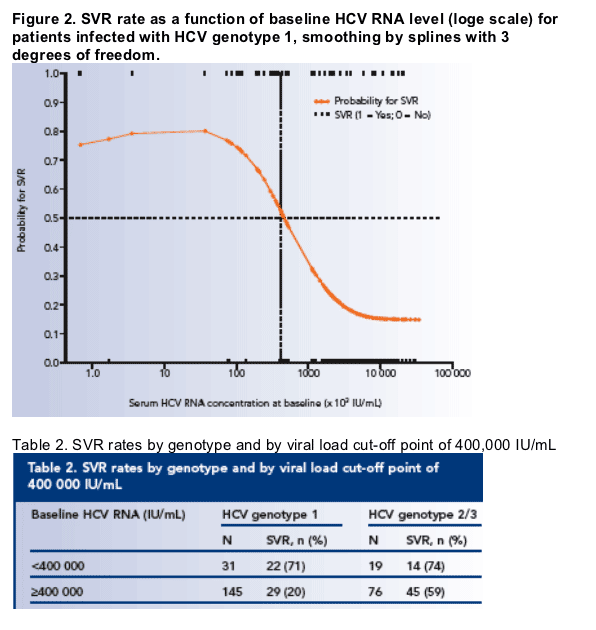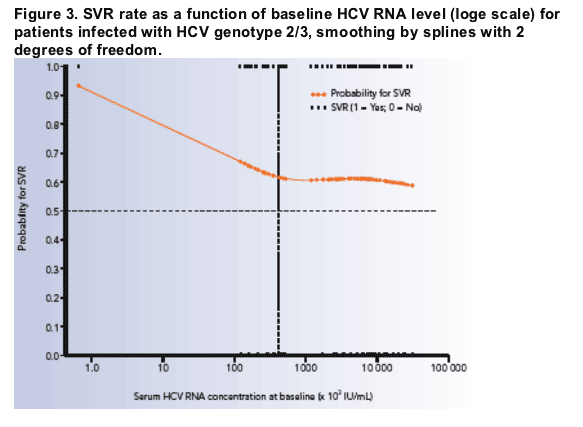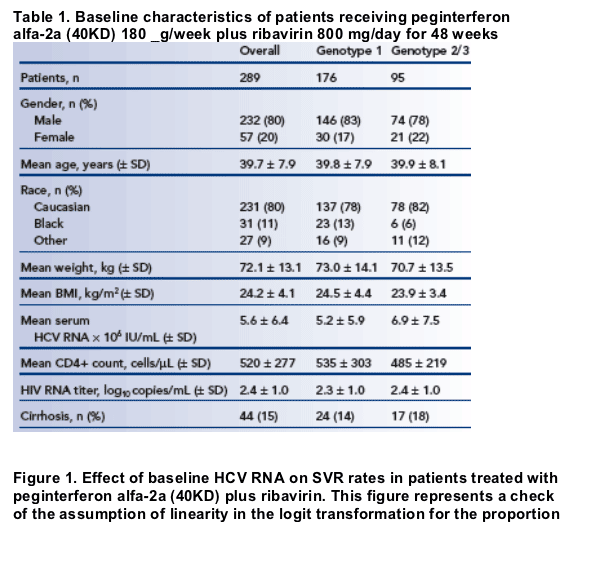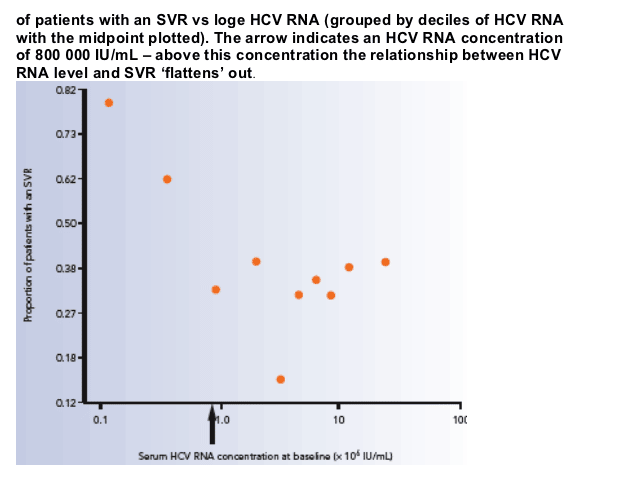 |
 |
 |
| |
Baseline viral load (400,000 IU/mL) as a predictor of SVR rate with peginterferon alfa-2a (40KD) (PEGASYS) plus ribavirin (COPEGUS) in HCV/HIV Coinfected in Apricot Study
|
| |
| |
Reported by Jules Levin
ICAAC, Sept 2006, San Francisco
M. Rodriguez-Torres,1 F.J. Torriani,2 E. Lissen,3 N. Bräu,4 M. Sulkowski,5 R. Sola,6 C. Tural,7 N. Clumeck,8 J. De Pamphilis,9 D. Messinger,10 D.T. Dieterich11
1Fundacion de Investigacion de Diego, Puerto Rico; 2University of California, San Diego, CA, USA; 3Virgen del Rocio University Hospital, Seville, Spain; 4Bronx VA Medical Center, NY, USA; 5Johns Hopkins University, Baltimore, MD, USA;
6Hospital del Mar, Universitat Autonoma de Barcelona, Barcelona, Spain; 7University Hospital Germans Trias i Pujol, Badalona, Spain; 8CHU Saint Pierre, Brussels, Belgium; 9Roche, Nutley, NJ, USA; 10IST, Mannheim, Germany; 11Mount Sinai School of Medicine, NY, USA
CONCLUSIONS
Currently, the outcome of therapy cannot be known in advance for an individual patient, irrespective of the baseline viral load. Therefore, all patients should be treated and evaluated at weeks 4 and 12 of therapy.
This analysis shows that, in patients with HIV-HCV co-infection, regardless of HCV genotype, a baseline HCV RNA level of approximately 400 000 IU/mL is the cut-off point which best discriminates the probability of achieving an SVR at a population level. In line with previous findings, this analysis shows that viral load has much less impact on SVR rates in patients with HCV genotype 2/3 than in patients with HCV genotype 1.
The HCV RNA 400 000 IU/mL cut-off point would therefore be the most appropriate for use, should further refinements of treatment options for patients based on viral load be considered.
INTRODUCTION
In the setting of human immunodeficiency virus (HIV)-hepatitis C virus (HCV) co-infection, treatment with peginterferon alfa-2a (40KD) (PEGASYS) plus ribavirin (COPEGUS) has produced significantly higher sustained virologic response (SVR) rates than peginterferon alfa-2a (40KD) monotherapy or interferon alfa-2a plus ribavirin (40% vs 20% and 12%, respectively; p<0.001).[1] As a result, the combination of pegylated interferon plus ribavirin is the treatment of choice for chronic hepatitis C in patients with HIV-HCV co-infection.[2]
Response rates to anti-HCV therapy in both HCV mono-infection and HIV-HCV co-infection are heterogeneous,[3] and numerous viral and host factors are associated with a lower treatment response. Genotype is the most important predictor of response, and current treatment guidelines take this into account.[4]
Baseline HCV RNA has also been identified as an important predictor of SVR. Earlier analysis of data from the AIDS PEGASYS Ribavirin International COinfection Trial (APRICOT), investigating the assumption of the linearity of the logit function, where HCV RNA levels were grouped by deciles (midpoint 811 000 IU/mL; range 422 000-1 200 000 IU/mL), showed that HCV RNA level (in loge scale) and SVR rates (in logit scale) were inversely proportional below approximately 800 000 IU/mL, but above this value the relationship flattened out (Figure 1).[5] Using a more refined cut-off point, it may be possible to further define 'easier' and 'difficult-to-cure' subgroups in this population, and so select an appropriate treatment strategy for these patients.
STUDY OBJECTIVE
To assist in the management of HIV-HCV co-infection, we used a more refined analysis than has been used previously to examine the baseline HCV RNA value that most effectively identifies patients most and least likely to achieve an SVR following treatment with peginterferon alfa-2a (40KD) plus ribavirin.
RESULTS
Viral cut-off point in HIV-HCV genotype 1 patients
The plots for probability of SVR as a function of baseline viral load (log-e scale) for patients infected with HCV genotype 1 are shown in Figure 2.
- for HCV RNA values below 105 IU/mL (100,000) a relative stable SVR of more than 70% can be observed, followed by a sharp decline to an SVR rate of less than 20% in patients with values above 2 x 106 IU/mL (2 million). The sharpest decline of the SVR curve is at about 400 000 IU/mL, which is also the level where the estimated SVR curve crosses the 50% level (i.e. when it becomes more likely to show a failure than success). Comparison of SVR rates using this cut-off point demonstrated that in patients infected with genotype 1 and with HCV RNA <400 000 IU/mL, SVR rates were high (71%) (Table 2).
- the SVR rate in patients with baseline HCV RNA 3400 000 IU/mL was only 20%
-- comparison of SVR rates using the cut-off points 800 000 or 1 200 000 IU/mL demonstrated less pronounced differences in SVR rates.

Viral cut-off point in HIV-HCV genotype 2/3 patients
The probability of SVR as a function of baseline viral load for patients infected with HCV genotype 2/3 are shown in Figure 3.
- for patients with values below 400 000 IU/mL a slight decline in SVR rates was estimated, followed by a relative stable SVR prediction of about 60% for patients with higher levels (Figure 3).
Comparison of SVR rates using this cut-off point demonstrated that in patients infected with genotype 2/3 and with HCV RNA <400 000 IU/mL, the SVR rate was 74% and 59% if >400,000 IU/mL (Table 2).

Baseline characteristics
Of 289 patients recruited to the study and treated with peginterferon alfa-2a (40KD) 180 _g/week plus ribavirin 800 mg/day for 48 weeks, 271 patients with genotypes 1, 2 or 3 were included in this analysis.
- 176 patients were infected with genotype 1 and 95 were infected with genotype 2/3.
The baseline characteristics of patients infected with genotype 1 and those with genotype 2/3 are shown in Table 1.
- overall, the baseline characteristics in this patient population treated with peginterferon alfa-2a (40KD) 180 _g/week plus ribavirin 800 mg/day are similar to those seen in the overall APRICOT population.
METHODS
Patients and study design
Patients eligible for APRICOT were those co-infected with the HIV and HCV viruses, naive to interferon and to ribavirin, with detectable HCV RNA (>600 IU/mL), elevated serum alanine aminotransferase (ALT), compensated liver disease and stable HIV disease. The full inclusion criteria and study design for APRICOT have been described elsewhere.[1]
Only data from patients with genotype 1, 2 or 3 who received peginterferon alfa-2a (40KD) 180 _g/week plus ribavirin 800 mg/day for 48 weeks were included in this analysis.
GAM analysis
SVR rate as a function of baseline HCV RNA was estimated using generalized additive model (GAM) analysis for binary data (logistic model).
- modelling was carried out using non-parametric smoothing splines. The generalized cross-validation method was used to find the optimized degree of freedom for the smoothing splines
- SVR rates were calculated for various cut-off points in the critical range around 800 000 IU/mL.


REFERENCES
1. Torriani F, Rodriguez-Torres M, Rockstroh J, et al. Peginterferon alfa-2a plus ribavirin for chronic hepatitis C virus infection in HIV-infected patients. N Engl J Med 2004; 351 (5): 438-50
2. Alberti A, Clumeck N, Collins S, et al. Short statement of the first European Consensus Conference on the treatment of chronic hepatitis B and C in HIV co-infected patients. J Hepatol 2005; 42 (5): 615-24
3. Zeuzem S. Heterogeneous virologic response rates to interferon-based therapy in patients with chronic hepatitis C: who responds less well? Ann Intern Med 2004; 140 (5): 370-81
4. National Institutes of Health. NIH Consensus Statement on Management of Hepatitis C: 2002. NIH Consens State Sci Statements 2002; 19 (3): 1-46
5. Cooper D, Torriani F, Rodriguez-Torres M, et al. HCV-related factors but not HIV-related factors at baseline predict the response to treatment with peginterferon alfa-2a (40KD) (PEGASYS) plus ribavirin (COPEGUS) in patients with HCV/HIV co-infection: predictor analysis from the APRICOT study. eJIAS 2004; 1 (1). Abstract MoPeB3329
|
| |
|
 |
 |
|
|